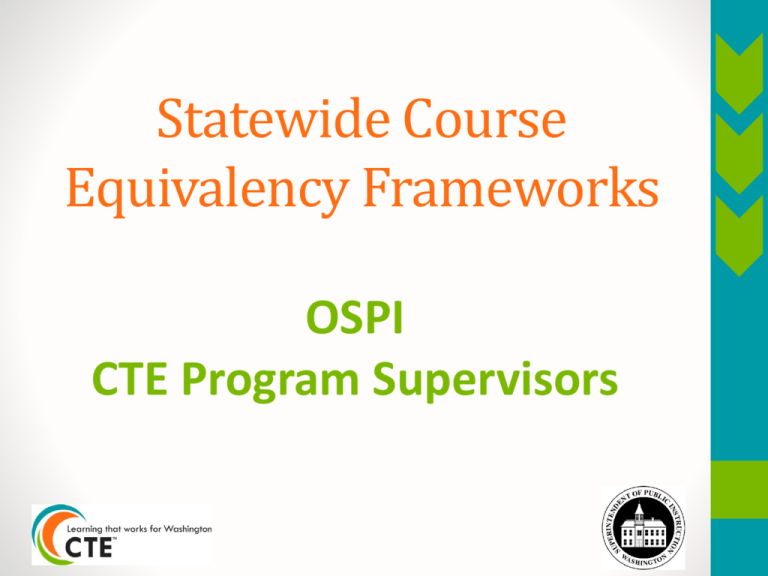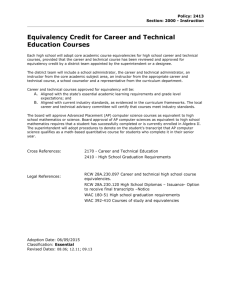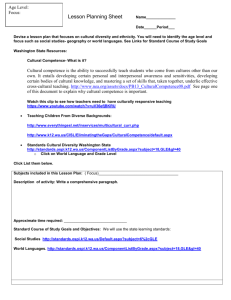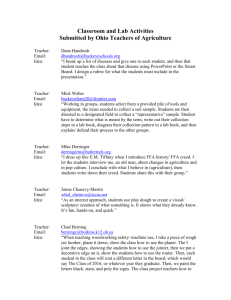PPT
advertisement

Statewide Course Equivalency Frameworks OSPI CTE Program Supervisors WHY WERE THESE COURSE FRAMEWORKS DEVELOPED? E2SSB 6552 The legislation passed in the 2014 session which amended RCW 28A.700.070, RCW 28A.230.097, and RCW 28A.230.010, required the development of statewide course equivalencies in Mathematics and Science for 21 CTE courses to enable districts to increase options for student choice in meeting graduation requirements. HOW WERE THESE COURSE FRAMEWORKS DEVELOPED? EQUIVALENT FRAMEWORK COURSES CTE Statewide Course Equivalencies Mathematics Equivalencies CIP Code CTE Course/Framework Credit Equivalency 149991 Engineering Design 1 190401 Consumer and Family Resources 270301 Applied Algebra 1 270305 Financial Math 100304 Animation Technology Video Graphics* 110803 Video Game Design/Digital Computer Animation* 460201 Residential Carpentry* 270301 Applied Algebra 2 Algebra 2 110201 Computer Programming 1 Credit Beyond Geometry 279998 Business Statistics Statistics • 540 Hour Skill Center Course • 360 HR High School or 540 Skill Center Algebra 1 Geometry CTE Statewide Course Equivalencies Science Equivalencies CIP Code CTE Course/Framework Credit Equivalency 010901 Animal Science 011101 Plant Science 030101 Natural Resources 030201 Natural Resources Management & Policy 190504 Food Science, Dietetics, and Nutrition 260102 Biomedical Sciences 260103 Biomedical-Body Systems 510808 Veterinarian Assistant* 511614 Nursing Assistant* 400891 Principles of Technology Applied Physics or Lab Science 110201 Computer Programming Science * 540 Hour Skill Center Course Biology or Lab Science Lab Science WHERE TO FIND THE FRAMEWORKS? http://www.k12.wa.us/CareerTechEd/default.aspx WHAT ARE THE COMPONENTS OF THE FRAMEWORK? Note: Unit Summary: Not included in all units of all frameworks The leadership alignment and performance assessments must be completed prior to submission to OSPI Standards may be added to these sections, but not removed WHERE ARE THE STANDARD RESOURCES? Science Standards • The 2013 Washington State Science Standards ARE the Next Generation Science Standards • The standards and background information can be found at www.nextgenscience.org/ • The science standards are aligned at the performance expectation level “HS.LS1-1” which reflects an integration of the three domains (Science and Engineering Practices-SEP, Disciplinary Core Idea-DCI, Crosscutting Concept-CCC) – This level is the alignment expectation for summative assessments • Additional SEP’s, CCC’s, and DCI’s may be aligned to formative assessments but must be integrated Math Standards • The Washington State K-12 Mathematics Learning Standards are the Common Core Math Standards • The math standards can be found http://k12.wa.us/Mathematics/Standards.aspx • Math alignment has been completed at the cluster level • If a course has been passed as a statewide science equivalent, there will not be math standards present Educational Technology • Some frameworks include educational technology alignment • The standards for educational technology are designed as grade level expectations for the use of digital technologies. They work compatibly, and practically, within Washington’s teaching and learning environment • The educational technology standards can be found at: http://k12.wa.us/EdTech/Standards/default.aspx • If not already included, it is not required to add these standards into your statewide framework CTE Industry Standards Each program area has unique Industry Standards. Information for specific Industry Standards can be found on the Framework Resource Companion in the standards and competencies section. The Framework Resource Companion is located on the OSPI-CTE website: http://www.k12.wa.us/CareerTechEd/A-Z.aspx WHAT MAY I ADD OR CHANGE ON THE FRAMEWORKS? Performance Assessment • Should reflect the summative and/or formative assessments used in the course • Should specifically show how student demonstrates understanding and competency related to the academic and industry standards • Specific projects, labs, quizzes, tests, activities and certifications are appropriate to include • Should clearly articulate alignment with the standards – tip: Pay attention to the SEP within the science standards to ensure the learning experienced is aligned • Must be developed locally prior to being submitted Leadership Alignment • Leadership alignment is required prior to submission of the state equivalent frameworks • Utilizing CTSO activities and curriculum is permissible if ALL students within the course are taking part in the event, during class time • Leadership alignment must include the activity/assignment/ learning experience MATCHED to the 21st Century Skill specific to the unit of instruction. (Skill definitions at p21.org) • Example: “Students will communicate clearly and work effectively in teams by completing their careers in industry group verbal presentation”. Additional Standards Any additional academic or industry standards if you teach and assess them in the course. “Two-for-One” Policy • WAC 180-51-067 • Rule change in effect for students in the graduating class of 2016 • Students who take CTE equivalent courses may satisfy two graduation requirements while earning one credit for a single course COMMON CONCERNS/QUESTIONS Frequently Asked Questions Do we have to use these frameworks when submitting within these CIP areas? No! Do not use statewide equivalents unless you can assure that the standards reflected are being taught and assessed within the course- local frameworks may still be developed and achieve local equivalency. My locally approved science or math equivalent CIP code isn’t on the list- does that mean I lose my equivalency? No! Local equivalents remain as local equivalents, the statewide adopted and approved list does not replace any locally approved equivalents. Why is my CIP code area not reflected, it should totally be an equivalent in math/science?! The first group of statewide equivalents needed to represent both high school and skill center, exploratory and preparatory, and each program area to allow for diversity of choice. Once potential courses were identified by OSPI staff, class counts were taken into consideration to maximize the impact. How should these courses be transcripted? • The course should be recorded on the student’s transcript using the equivalent academic high school department designation and title. • Work with the appropriate school personnel to ensure that the courses are accepted as equivalents by post-secondary institutions. Animal Science courses that are Biology equivalents should be transcripted as biology. Transcripting is a LOCAL issue, suggestion is to ensure there is an academic and occupational state course code. • Information can be found in the Equivalency Credit Tool Kit 3.3 at: http://www.k12.wa.us/CareerTechEd/Forms/EquivalencyCreditToolkit.pdf How will this impact NCAA approval? NCAA looks at course titles and may request course descriptions – all is handled at the local level. Is my district required to use these frameworks? No, you may continue to use your locally developed framework. However, for statewide equivalency you must use the newly developed framework for credit equivalency. Does my district have to offer an equivalency? E2SSB 6552 amended the RCW to say that districts must provide access to at least one CTE course equivalent to math or science. OSPI Contacts Name Program Area E-mail Lance Wrzesinski Business and Marketing lance.wrzesinski@k12.wa.us Marianna Goheen Health Sciences marianna.goheen@k12.wa.us Mary Nagel Family and Consumer Sciences mary.nagel@k12.wa.us Dennis Wallace Skilled and Technical Sciences dennis.wallace@k12.wa.us Clarence Dancer STEM clarence.dancer@k12.wa.us Becky Wallace Agriculture rebecca.wallace@k12.wa.us Anne Gallagher Mathematics Director anne.gallagher@k12.wa.us Ellen Ebert Science Director ellen.ebert@k12.wa.us






